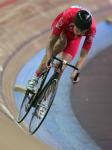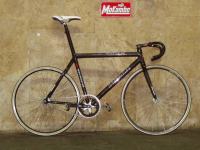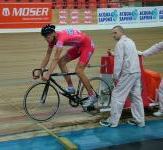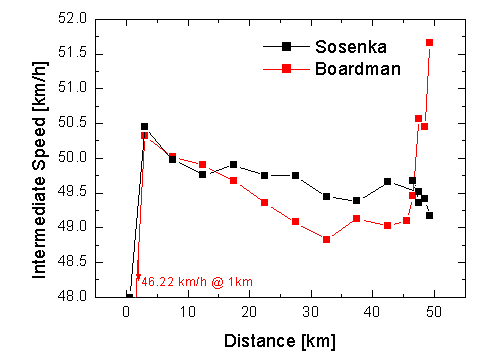Ondrej Sosenka (Moscow, 19.7.2005, 49.700 km)
When I heard about this attempt, I thought "Ondrej WHO?". But
it seems that almost everybody underestimated this fine athlete!
49,700 km are really fantastic, congratulations!
He was faster than Boardman from the very start of his effort,
recording a time of 1'15.01 (versus 1'17.891) for the opening kilometre. He
went through the 5 kilometre point over three seconds up, and by the 25
kilometre point he had extended his advantage to just under 7 seconds. This
continued to grow to 18 seconds by 40 kilometres.
In his attempt, Sosenka was using a 54 x 13 gearing, a 3.2 kg wheel and
190 mm cranks, with his bike weighing a total of 9.8 kg. The reason for the
heavy wheel was that although it was harder to get up to speed, it was easy
to maintain it.
(Remark: This paragraph was taken from an article in
cyclingnews.com. Hmmm, the good old flywheel effect...
But if used for track cycling, its advantage is discussed controversial.
Eddy Merckx
put in a huge effort to get his bike as light as possible...)
The handlebar of his bike was
set very low. This allowed him to keep the arms more or less stretched out and
still get a very low position. I assume that this position is much more
comfortable than Boardman's - AND has aerodynamic advantages.
Check out
Ondrej's website
Article in
cyclingnews.com
Article in
procycling
Article in
Radio
Prague |
 |
 |
 |
 |
| www.radsport-forum.de |
www.radio.cz |
www.sosenka.cz |
www.sosenka.cz |
Look at more photos on
Ondrej's photogallery
Split times are taken from
www.sosenka.cz/rozpis.html |
Split Times
km
| Merckx
Mexico City,
25.10.1972 |
Boardman
Manchester,
27.10.2000 |
Sosenka
Moscow,
19.7.2005 |
|---|
| time |
avg. speed |
time |
avg. speed |
time |
avg. speed |
| 1 |
1.10 |
51.43 |
1.17.891 |
46.218 |
1.15.01
|
47.996 |
| 5 |
5.55.7 |
50.60 |
6.04.016 |
49.448 |
6.00.42
|
49.942 |
| 10 |
11.53 |
50.49 |
12.03.889 |
49.732 |
12.00.59
|
49.959 |
| 15 |
18.01 |
49.95 |
18.04.635 |
49.786 |
8.02.33
|
49.892 |
| 20 |
24.07 |
49.76 |
24.06.975 |
49.759 |
24.03.05
|
49.894 |
| 25 |
30.10 |
49.72 |
30.11.663 |
49.678 |
30.04.89
|
49.865 |
| 30 |
36.17 |
49.61 |
36.18.409 |
49.577 |
36.06.73
|
49.845 |
| 35 |
42.25 |
49.51 |
42.27.043 |
49.469 |
42.10.81
|
49.786 |
| 40 |
48.32 |
49.45 |
48.33.402 |
49.427 |
48.15.32
|
49.735 |
| 45 |
54.38 |
49.42 |
54.40.588 |
49.381 |
54.15.?? |
49.727 |
| 46 |
- |
- |
55.53.916 |
49.375 |
55.30.50
|
49.722 |
| 47 |
- |
- |
57.06.713 |
49.377 |
56.42.97
|
49.721 |
| 48 |
- |
- |
58.17.899 |
49.401 |
57.55.90
|
49.714 |
| 49 |
- |
- |
59.29.264 |
49.422 |
59.08.75
|
49.708 |
| 49.25 |
|
- |
59.46.661 |
49.433 |
- |
| | 1 hour |
49.431 |
49.431 |
49.441 |
49.441 |
49.700
|
49.700 |
|
| |
|
One can use the split times to plot the average speed at a
given distance. Boardman started quite slow, but after some kilometers
with a speed around 50 km/h he reached an average speed of about 49.7 km/h.
Then he went slower and slower, until his final effort pushed him to
49.441 km.
Sosenka started quite fast, he gained almost 3 seconds in the first km
compared to Boardman, though he was still five seconds slower than Eddy
Merckx 1972! After 10 km he marked his hightest average speed, quite close
to 50 km/h. He then slowly faded to the final mark of 49.7 km/h

Now lets calculate the speed for the 5 km intervals (or 1
km
intervals):
In the first 10 km Sosenka and Boardman rode almost at the
same speed, but Sosenka had covered the first km 3 seconds faster, that
gave
him the advantage in the average speed (look above). But after 15 km
Boardman faded and his speed dropped even below 49 km/h. In the last three
minutes he gave it all, riding some laps with more than 51 km/h.
Sosenka's ride was much smoother, just slowly getting slower.

|
|
Back to hour record page |
|
|
|